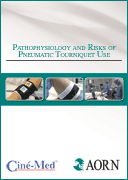Pathophysiology and Risks of Pneumatic Tourniquet Use

| Product Details | |
| Product ID: | 1966 |
| Year Produced: | 2013 |
| Length: | 30 min. |
Contact Us: 1-800-253-7657
Exsanguination, pneumatic tourniquet inflation, and subsequent deflation cause local and systemic physiologic responses that perioperative nurses must understand to have a better grasp of the patient's risk for pneumatic tourniquet-related complications. By understanding patient- and practice-specific risk factors for pneumatic tourniquet-related complications, perioperative nurses also can communicate and collaborate effectively with anesthesia professionals and surgeons; assess and monitor patients before, during and after surgery; and decrease the likelihood of adverse outcomes from pneumatic tourniquet use.
Upon completion of this activity, the participant will be able to:
- Describe the body's physiologic responses to inflation and deflation of a pneumatic tourniquet
- Relate these physiologic responses to local and systemic complications that have been reported for patients who have undergone pneumatic tourniquet-assisted procedures
- List patient-specific and practice-specific risk factors for complications related to pneumatic tourniquet use



